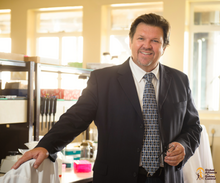Recent progress drives a new vision for GARC in the year ahead.

With a world emerging from under the pandemic clouds of 2020 and 2021, the past year was characterized by a number of significant positives for rabies communities around the globe.
Many were able to re-engage with rabies control activities in communities that could appreciate the value of vaccination and One Health a little better and World Rabies Day data confirm a record upslope in activities around the world (up by 20% from 2019). WRD and other accomplishments for 2022 are further discussed in this newsletter and elsewhere.
For me, the most significant highlight of 2022 was the pleasure and privilege to be able to co-host the first major in-person international rabies meeting in almost 3 years. This meeting, “Strengthening international engagement to support the Zero by 30 Global Strategic Plan (Zero by 30)”, was in fact the 13th Partners for Rabies Prevention meeting and was held at the Les Pensières Centre for Global Health, Veyrier-du-Lac, France, 13-15 June 2022.
The complete meeting report is available here. Briefly the meeting was hosted and co-organized by the Global Alliance for Rabies Control and Fondation Mérieux and brought together international rabies stakeholders from around the world in order to review the current global rabies situation following the COVID-19 pandemic. The work of the meeting was aligned with thematic activities of the three Working Groups and associated workstreams of the UAR Forum, in keeping with the goals of Zero by 30. As GARC has acted as secretariat for the Partners for Rabies Prevention (PRP) network, supporting international rabies stakeholders’ activities and collaboration, we also considered strategic questions regarding the future of the PRP, as the UAR Forum could replace what was historically the purpose of the PRP.
Given the progression of the global strategic plan (GSP), and the UAR Collaboration and Forum, I made the case that GARC’s PRP initiative should now move away from international coordination to focus on, and be comprised of, civil society community actors, whose contributions are sometimes neglected at the international level. Over the years I have learned to appreciate the critical role that communities and civil society play in day-to-day rabies control efforts around the world, and I am convinced that we will not succeed in the goals of the Global Strategic Plan without these partners on board. As we have done in the past with other stakeholders, we will offer support and play a unifying role.
In today’s rabies arena, numerous non-profits, charities, and individuals make a very real difference because they believe that they can make a difference; and while they are often quite small, they are passionate, often willing to go the extra mile, and collectively represent a significant tour de force. We believe that we can and should provide better support and encouragement, include them as important actors in a bigger play, advocate for them and help them to align with a global UAR strategy and goal. Tangibly, among the outcomes of such an approach we could foresee a better distribution of deliverables, uptake of strategic tools and access to a broader funding base.
As the historical custodian of the PRP, we were most encouraged by the receptive and positive response to this new venture from our international stakeholders and local community actors we have engaged with, and since our meeting in Annecy, we have been hard at work on this new endeavour. Thank you and watch this space!